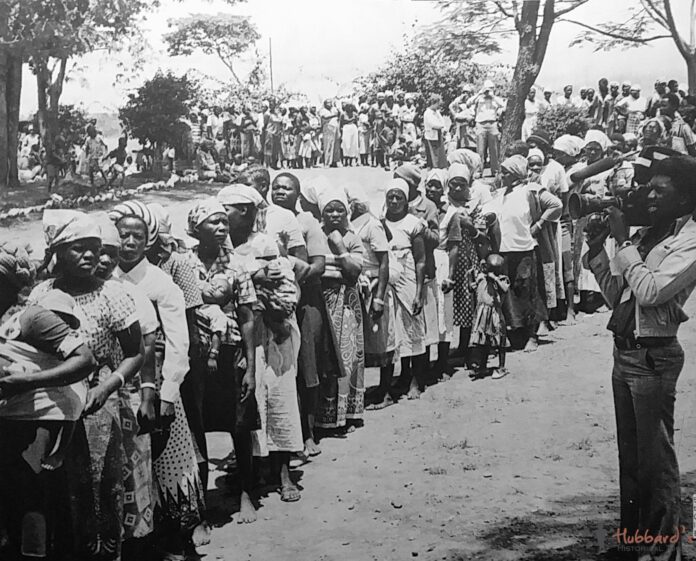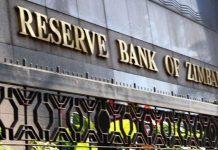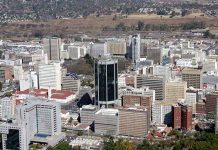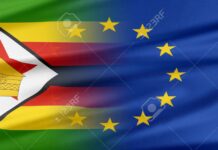The Moniness of Money in Zimbabwe: Political but not economic independence
Tinashe Nyamunda
Equity, production and currency
At Lancaster, the burning issue had been that of land. As I write this article in a post-land resettlement dispensation, the issue has become topical once more as the government has set aside over US$3.5 billion dollars to compensate white farmers ostensibly for improvements on the land. This issue has caused serious political attacks on the country’s government, not just locally, but regionally from organisations such as South Africa’s Economic Freedom Fighters. While Robert Mugabe’s regime had been criticised for the ways in which it grabbed land from white farmers and the ways it distributed it largely amongst political elites, many commentators accepted that the principle was long overdue.
The connection between access to the means of production, whether in land and ownership of property and certain other kinds of business is equity. When the colonial settler state seized productive land from Africans and gave it to white farmers under a legal regime of private ownership, they created the basis for the colonial economy. Even though the currency used was British sterling and the major commercial banks, Standard Bank and Barclays were expatriate, white commercial farmers, business owners and industrialists could use their assets to access finance to fund their business activities. Others without access could draw up business plans and use them to borrow or white workers could use their access to well-paying jobs to get government guaranteed mortgages to purchase properties in prime suburbs. Once they bought these houses, they could use them as collateral to finance other business activities. In a system of this kind, those with access to means of production could then work towards creating wealth. They could convert this capacity into profit, hence “vaikwanisa kugadzira mari” (they were able to make money)!
But as the previous article in this issue revealed, black people were excluded from this system. Not only were they removed from the land and therefore their means of production, but the land tenure system used in the reserves in which they were all bundled was communal and in this case, their land could not be used as collateral to access finance from the banks. Kuma rizevha (In the reserves), the chief had the right to grant access to land which villagers could sell without consent. Most of the production that occurred there was limited to subsistence and not much could be earned in terms of income after selling off the little excess. By their very nature, as Ben Magubane observed in his 1979 book: The Political Economy of Race and Class in South Africa, the Reserves were designed to be reservoirs of cheap labour which could be employed on the farms, mines and businesses, in the colonial economy controlled and managed by the white colonial state and settler community.
In a book entitled The Two Nations: Aspects of the Development of Race Relations in the Rhodesias and Nyasaland, Richard Gray examines how such policies created the so called traditional or “native” economy developed as separate from the money economy that served white interests. Indeed, among the most prominent architects of the two pyramid policies, Prime Minister Godfrey Huggins applied segregationist policies of protecting the so called “island of white” from erosion from a “sea of black”. This was achieved through the colonial state’s maintenance of political and economic hegemony. Indeed, the application of a racialized two pyramid approach to politics and economy was a fiction created foe legibility and control of Africans in the colonial period. gotas de ivermectina para perros Gray examines the political economy of what became a two in one nation with “vaive ne mari”, those who had money who tended to be predominantly white and those who were reserved as a mass of cheap labour.
Ultimately the rural or immigrant Africans were coerced by poverty conditions, (barring the very few granted access to some fairly well paying jobs because of some education they attained later on in the colonial period or access to purchase area smaller African farms) to seek employment kune varungu (white bosses) vaive nemari (who had money). But these white money-makers attained this status by using their colonial political power to secure control of the means of production. When the Rhodesian Front government rebelled against the British imperial state, it was this system they wanted to protect. Even as the war of liberation intensified and majority rule became inevitable, the Rhodesian Front government’s strategy was to secure sufficient bargaining power to retain a significant degree of economic control.
At the Lancaster negotiations, as the previous article showed, they retained colonial structures of the economy, including the institution of private property which had to be respected for the first decade of independence. In this context, what changed at independence was the political leadership which Robert Mugabe and ZANU PF won at independence, but little else. The Reserve Bank dropped the name Rhodesia for Zimbabwe. The Rhodesian dollar became the Zimbabwean dollar as part of the name changes in the streets, for instance. But apart from these cosmetic changes, there were really no structural changes in the economy. The ideas about who provided employment (varungu) who had money (vaiva nemari) remained, even long after land reform. Now with the latest developments, white farmers who had been expelled from the land are again accessing money from a government desperate to use what they perceive as white geopolitical influence to try and campaign for the removal of United States and European Union sanctions. Ultimately, as Andre Astrow observed in his 1983 book, Zimbabwe is a revolution that lost its way.
Currency, planning and the Economy in the 1980s
After attaining power in the 1980s, the government was faced with the task of managing the economy. If one was to look at clips of euphoric people that were interviewed following ZANU PF’s election victory in 1980, they would observe that many expected rapid and radical transformation of the economy. In the eyes of these people, the government would improve their economic status by providing land, jobs and opportunities to make money. The electorate expected that the white man would no longer have a monopoly over access to opportunities of making money or the means of production. But as Ibbo Mandaza and his colleagues showed in the 1986 edited collection, Zimbabwe: The Political Economy of Transition, transformation would neither be rapid nor radical.
Even as early signs of frustration crept in as shown either by black peasant farmers’ demands for land or by workers’ wild cat strikes in the 1980s, government response was either piecemeal or negative. In the commercial and industrial sector, the changes that took place were quite miniscule. The economy remained in the hands of white and foreign capital. Any efforts to promote African entrepreneurship through such organisations as the woefully underfunded Small Enterprises Development Corporation met very limited success. Despite some strides in such pro-worker legislation as the Labour Relations Act (1985), strikes were met with sometimes brutal state retaliation. Where land was concerned, the Market Led Agrarian Reform (MLARS) approach only managed to resettle no more than 55000 families in the 1980s in a context where the government was never fully committed to the process. If anything, the key development of the 1980s was the attempts by Mugabe to stamp out opposition from the main opposition party, PF ZAPU in his attempts to establish a one party state. In the end, as Mandaza and other scholars in the book on Zimbabwe’s transition showed, the ZANU PF government was not keen on such radical changes and therefore opted to limit themselves to piecemeal currency and other name changes.
The abandonment of the transformation agenda is informed by at least two reasons. The first and most convenient justification for suspending any real transformation for the state was the limitations of the Lancaster House agreement. Its restrictions, some of which were examined in the previous article in this issue, legally bound the government from flouting the institution of private property and thus, in many respects maintain colonial economic structures. The second and more profound reason, in my view, is one informed by the technocrats appointed to manage the economy. Prominent among these were people such as Bernard Chidzero, Zimbabwe’s post-independence Minister of Economic Planning and Development who later became the Minister of Finance in 1983, becoming the longest serving Minister of Finance in Zimbabwe. Neither he, nor most economists he worked with were keen on radical transformation.
Among the reasons that explain their position was their education. I have explained in previous articles the ways in which the System of National Accounting (SNA) works. So, I will not exhaust that here. كم عمر روني But in short, their notions of how any economy works were based on the country’s Gross Domestic Product metrics. This was informed by how much was commercially produced, exported and how much foreign exchange was earned. جميع المواقع التي تقبل الدفع بالباي بال paypal Floated against the US dollar, their notions of success were the value that the local Zimbabwean dollar held against the greenback. Adhering to economic planning on this basis was not only the price paid for gaining access to the United Nations (UN) and its various wings such as the International Monetary Fund (IMF) and the World Bank, but it was also the logic upon which their education about economic administration was informed. Unfortunately, I argue, this resulted in drawing the country into the neo-colonial SNA trap which fueled what I have termed (borrowing with adjustment from scholars John Gallagher and Ronald Robinson) ‘the imperialism of free trade’. This is also what decoloniality scholars such as Sabelo J Ndlovu Gatsheni have called Coloniality and African subjectivity in his assessment of the reformed global empire. Unfortunately, the language of re-engagement by the current Mnangagwa regime and his neo-liberal inclined finance minister, Mthuli Ncube, can only perpetuate this position. Ultimately, the post-colonial economy was founded on highly problematic notions of what an economy is, how it should be managed and the retention and sustenance of colonial institutions.
SNA Economic Management and its Results until 1990
When the new government took over in 1980, its task was to stimulate the growth and development of the economy. Here, I must note that the concept of growth is problematic, as is development. You can have one without the other. But more importantly, even if there is economic growth, and even if there is development, whatever that is taken to mean, this can occur without reducing inequalities or improving the welfare of the generality of ordinary people. Nevertheless, without paying much attention to these contradictions, the government sought to pursue such policy agendas. To grow the economy without transformation, the ZANU PF government decided to look for international aid to repair infra structure damaged during the war and spend money in improving the rural areas.
Ironically, rural development was nothing new. The Smith regime, in attempting to ‘develop’ the African in his own area had pursued a problematic policy of community development not so dissimilar to the one pursued by the post-colonial government through the District Development Fund (DDF). In many ways, almost replicating the two-pyramid illusion of a disconnected ‘traditional’ but actually really reserve economy versus the capitalist urban economy, such policies perpetuated colonial era policies and in some ways reinforced them. Nevertheless, because the ZANU PF government had inherited an indebted economy with limited funds, they sought to raise funds from the international community to implement their otherwise non-transformative problematic policies.
Minister Chidzero and others were critical in hosting the 1981 Zimbabwe Conference on Reconstruction and Development. Not only did they seek to raise funds, but they also hoped to attract investors, starting a legacy of externally aided notions of development that persist to date. In fact, subsequent finance, and economic planning ministers since then have failed to imagine any other alternative ideas of development not limited to aid, loans and trying to attract external investors. In their minds, the value of the local currency and economy can only be measured by how many US dollars the country holds at the Reserve Bank, no matter how that money was attained, even if it is through debt. Anyway, over US billion was raised from the pledges made by many countries at the conference. سعر اشتراك يورو 2023 Some investors such as Heinz, among others, were attracted to invest after assurances were given that the government would not nationalize their companies and therefore undercut their investments. The institution of private property would be retained, and private companies’ profits protected. But this excluded the general populace who would remain mere workers and peasants. Without fully considering this reality, Chidzero argued that the funds raised would allow the country to become economically self-sufficient within three years.
Despite the aspirations to use aid to develop the country and grow the economy, what eventually transpired was the opposite. By 1987, under pressure from social expenditure in education and public health, the fiscus was largely drained and the government faced huge public debt. In the private sector, production declined in the 1980s and the revenue raised to support this recurrent expenditure was inadequate. Part of the reason the government was forced to spend significantly on education, health, rural development and basic commodities subsidies was to appease the populace that was increasingly agitated by not realising any concrete transformation after independence in terms of access to the means of production and other opportunities. Ultimately this mismatch came to bear within the economy. As floating also resulted in a Balance of Trade deficit as the country’s export capacity failed to match its import requirements, Zimbabwe fell into debt. There were pressures to devalue the currency, but this would have given the impression that the economy was contracting. Ultimately, the government opted to borrow from the IMF and World Bank in an attempt to restore economic equilibrium and pay off the huge public debt. But this move, adding on to inherited colonial legacy debt, only delayed the collapse.
Moreover, the concentration of ZANU PF on trying to create a one-party state and how it expended its efforts in the Gukurahundi massacres in the 1980s shifted the country’s leaders’ attention from imagining ways of rethinking and transforming the economy. Instead they divided the country along party lines and to a significant degree, ethnic lines. The massacre of 20 000 people in the Midlands and Matabeleland province testifies to this. ivexterm 4 tabletas precio farmacia del ahorro Among other ways to try and retain power, the ZANU PF government established a patronage network in which political supporters and government elites benefited from the party. Repression and the scourge of corruption that has become so endemic today and is topical following the unconstitutional arrests of such journalists as Hopewell Chin’ono and politician Jacob Ngarivhume has its roots in the 1980s. While a few individuals were arrested in the early scandals in the 1980s for flouting, among other laws, exchange control regulations, the catch and release practice that the public has become so accustomed to, began in those years. All of these problems contributed to the contraction of the economy as high level elites flouted such regulations as exchange control, one of the pillars of managing currency. Today, we observe politically connected elites diverting millions of US dollars to non-essential imports such as sports cars as socialites like Ginimbi and others boast about on social media. Whether these individuals are capable of making such connections or not is beside the point, but it is their activities that contribute to the further weakening of currency and therefore economic contraction. “Vana ginimbi ndovave varungu vacho sezvo varivo vane mari!” (the likes of Ginimbi are the new whites since they have the money), said a friend of mine the other day. In short, the authoritarian nature of the colonial state and its institutions have been taken over by a political minority to benefit only those with access to the corridors of power and their clients. Such money as Ginimbi, Wicknel Chivayo and other socialites have attained, allegedly through corrupt means, could be better spent importing essential productive commodities, only if the SNA that the government adheres to were to be strictly enforced under conditions where their imagination is lacking. However, in the 1980s, as these developments began to occur, contraction began, debt expanded and by the 1990s, Zimbabwe needed external Balance of Payment support and funds to settle debt. The money that the IMF and World Bank would loan to Zimbabwe would only be released on condition the country implemented an Economic Structural Adjustment Programme, the subject of the next article.
Conclusion
Zimbabwe inherited a potentially vibrant and diversified economy. But it was characterized by racial economic inequities that need to be addressed. Among the ways the liberation movements promised to do this once they attained political power was through rapid and radical economic transformation within the economy, particularly land redistribution. But as the forgoing has shown, the revolution that party claims to continue leading has clearly lost its way. Among the reasons for this are the ways in which it conceded to an unfavourable settlement at Lancaster. But more importantly for me, the technocrats that the ZANU PF government appointed, followed an economic planning trajectory that abandoned the promises of transformation in the first twenty years of the country’s political independence. Meanwhile, political persecution and the culture of corruption took root as the country went down a perilous path. solvet ivermectin By 1990, as will be explored in the next article, apart from the name Zimbabwe dollar, the country’s authorities had lost control of their currency and were subject to external forces over how to recover its value and manage their economy.










